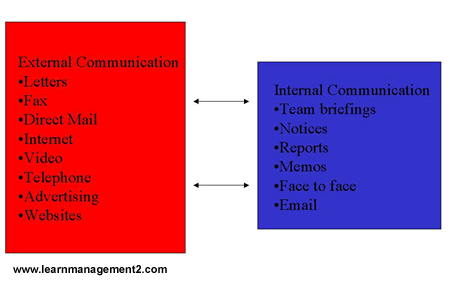|

For management learners globally
Home | Management Concepts | Newsletter | About | Contact | PowerPoints | Management Cliparts |
COMMUNICATION TYPES - Page 2 of 2
Internal/Organisational Communication
This is communication that takes place within (or across) an organisation. In addition to the usual face to face, telephone, fax or mail; modern organisations may use technology to communicate internally. Technology may be used for e-mails or a linked internal communication system such as the intranet which is an internet system designed solely for use by those working for the organisation.
External communications
Conversely external communication is communication between the organisation and those outside the organisation. Modern organisations may design technological systems so that they can communicate with customers and undertake e-Commerce. Alternatively they communicate with other businessess through the internet or similar systems and undertake e-Business.
Functions of Internal and External Communications;
Technology has rapidly expanded the types of internal and external communication available to organisations. The diagram illustrates the vast array of internal and external communication available.
Combined together internal and external types of communications allow various sectors of the local, national and international community to interact, liaise and conduct business.

Formal and Informal Communications
Formal communication is defined as communication which occurs through the official organisational channels or is undertaken by an employee to do their job. For example official meetings, letters and a manager asking an employee to carry out a particular task. Conversely informal communication is that which occurs outside the recognised communication networks such as talking in the lunchroom or hallways between employees. Informal communication can be productive or negative. It has the potential to build teams, improve working relationships and generate ideas as employees are in a relaxed environment.
Upward and Downward Communications
Downward communication is communication created by directors and managers and passed down the hierarchy of workers in the organisation. In traditional organisations this is the preferred method of communication ie Managers decide what the systems, rules and procedures will be and then they pass these down to employees they manage and supervise. Downward Communication can increase efficiency by synchronising organisational procedures and can ensure that everybody is working towards the same overall aims and objectives. Types of downward communication include job descriptions, appraisals/evaluations, organisational policy, and organisational systems.
Although there are advantages to downward communication organisations have began to encourage upward communication. This is communication which originates at the lower level of the employment hierarchy and is then communicated up through the line. Organisations encouraging upward communication believe that everybody is capable of generating thoughts and ideas which may help the organisation to progress, particularly when they are working closely in the area that the idea applies to. Upward communication may increase motivation and make employees feel valued and respected whilst enabling managers to understand how employees are feeling. Furthermore if problems occur at they are more likely to be identified earlier by those working closely in the area that they occur. Types of upward communications include suggestion schemes, feedback forums/surveys, grievance procedures and employee-manager discussions.
Lateral Communication
This is communication that occurs between employees on the same level in the organisation. As this can involve decision making it can create efficiency as employees do not have to wait for managerial approval. On the other hand if the manager is not kept informed or if the manager fails to set boundaries there is potential for conflict.
Diagonal Communication
This occurs when communication occurs between workers in a different section of the organisation and where one of the workers involved is on a higher level in the organisation. For example in a bank diagonal communication will occur when a department manager in head office converses with a cashier in a branch of the bank based on the high street.
TELECOMMUNICATIONS GLOSSARY
Term |
Definition |
Telecommunication |
Communication between parties based in different locations by using a cable, telephone, broadcast or a telegraph. |
Networking |
Linking to or more computers together so that information and facilities can be shared. Computers in the same room may be linked together or the organisation may decide to link, computers in different parts of the world together. |
Local Area Network (LAN) |
Computers linked by a network without the use of telecommunications. Often the computers linked are based in the same location, group of buildings or site. |
Wide Area Network (WAN)
|
Computers linked by a network using telecommunications. Often the computers linked are based in different locations. |
Teleconferencing
|
Through the use of telecommunication devices such as video link participants based in different locations communicating is known as teleconferencing. |
Electronic Data Interchange (EDI) |
Computer networks used to exchange standard business transaction documents between organisations. |
|

